Mineral Resources Policy for a Circular Flow of Critical Minerals: An Input–Output Approach to the Case of Their Final Destination in Japan
Abstract
1. Introduction
2. Materials and Methods
2.1. Element Selection of Critical Minerals
2.2. Input–Output Analysis
3. Results and Discussion
3.1. Test of the Estimated Element Composition of Products ()
3.2. Final Destination (Domestic Final Demand and Export) of Critical Minerals as Annually Accumulated Social Stocks
3.3. Decision Flow Framework of Mineral Resources Policy from National Security and Circular Economy Aspects
4. Conclusions and Outlook
Author Contributions
Funding
Institutional Review Board Statement
Informed Consent Statement
Data Availability Statement
Acknowledgments
Conflicts of Interest
References
- Australian Government. Australian Critical Minerals Prospectus 2020; Australian Trade and Investment Commission: Sydney, Australia, 2020.
- Canadian Government. Canada’s Critical Minerals Strategy. 2022. Available online: https://www.canada.ca/en/campaign/critical-minerals-in-canada/canadian-critical-minerals-strategy.html (accessed on 28 November 2023).
- European Commission. 2020 EU Critical Raw Materials List. EU (European Union). 2020. Available online: https://eur-lex.europa.eu/legal-content/EN/TXT/PDF/?uri=CELEX:52020DC0474&from=EN (accessed on 28 November 2023).
- METI (Ministry of Economy Trade and Industry Japan). Initiatives to Ensure Stable Supply of Critical Minerals. Tokyo. 2023. Available online: https://www.meti.go.jp/policy/economy/economic_security/metal/torikumihoshin.pdf (accessed on 3 December 2023).
- Malala, O.N.; Adachi, T. Japan’s critical metals in the medium term: A quasi-dynamic approach incorporating probability. Miner. Econ. 2022, 35, 87–101. [Google Scholar] [CrossRef]
- Korean Government. New National Strategies for Securing Strategic Minerals for Korea. Korea. 2023. Available online: https://www.korea.kr/briefing/pressReleaseView.do?newsId=156554864 (accessed on 29 November 2023).
- British Geological Survey. UK Criticality Assessment of Technology Critical Minerals and Metals: Decarbonisation & Resource Management; British Geological Survey: Nottingham, UK, 2021. [Google Scholar]
- US Government. Critical Minerals and Materials: US Department of Energy’s Strategy to Support Domestic Critical Mineral and Material Supply Chains. United States of America. 2021. Available online: https://www.energy.gov/sites/prod/files/2021/01/f82/DOE%20Critical%20Minerals%20and%20Materials%20Strategy_0.pdf (accessed on 28 November 2023).
- NRC (National Research Council). Minerals, Critical Minerals, and the U.S. Economy; National Academies Press: Washington, DC, USA, 2008. [Google Scholar] [CrossRef]
- European Commission. Raw Materials Initiative. EU (European Union). 2008. Available online: https://eur-lex.europa.eu/legal-content/EN/TXT/?uri=CELEX:52008DC0699 (accessed on 28 November 2023).
- Japan Cabinet Office. Guidelines for Securing Resources; Japan Cabinet Office: Tokyo, Japan, 2008.
- Japanese Government. Procurement Strategy of Rare Metals. Japan. 2009. Available online: https://warp.da.ndl.go.jp/info:ndljp/pid/6086248/www.meti.go.jp/press/20090728004/20090728004.html (accessed on 28 November 2023).
- UK Government. Resilience for the Future: The UK’s Critical Minerals Strategy. UK. 2023. Available online: https://www.gov.uk/government/publications/uk-critical-mineral-strategy/resilience-for-the-future-the-uks-critical-minerals-strategy (accessed on 28 November 2023).
- Japanese Government. Sixth Strategic Energy Plan—2050 Carbon Neutral. Japan. 2022. Available online: https://www.meti.go.jp/english/press/2021/1022_002.html (accessed on 28 November 2023).
- French Government. Resources for France Plan. France. 2018. Available online: https://www.ecologie.gouv.fr/sites/default/files/FREC%20-%20Plan%20Ressources%20pour%20la%20France%202018.pdf (accessed on 28 November 2023).
- European Commission. European Action Plan on Critical Raw Materials. EU (European Union). 2020. Available online: https://eur-lex.europa.eu/legal-content/EN/TXT/?uri=CELEX:52020DC0474 (accessed on 28 November 2023).
- German Government. Raw Materials Strategy of the Federal Government: Securing a Sustainable Supply of Non-Energy Mineral Raw Materials for Germany, Updated. 2019. Available online: https://www.bmwk.de/Redaktion/DE/Publikationen/Industrie/rohstoffstrategie-der-bundesregierung.pdf?__blob=publicationFile&v=4 (accessed on 3 December 2023).
- Spanish Government. Roadmap for the Sustainable Management of Mineral Raw Materials. Spain. 2021. Available online: https://www.miteco.gob.es/es/prensa/ultimas-noticias.html (accessed on 28 November 2023).
- Ellen MacArthur Foundation. Circular Economy Towards the Economic and Business Rationale for an Accelerated Transition. 2013. Available online: https://emf.thirdlight.com/file/24/xTyQj3oxiYNMO1xTFs9xT5LF3C/Towards%20the%20circular%20economy%20Vol%201%3A%20an%20economic%20and%20business%20rationale%20for%20an%20accelerated%20transition.pdf (accessed on 3 December 2023).
- Lewandowski, M. Designing the Business Models for Circular Economy—Towards the Conceptual Framework. Sustainability 2016, 8, 43. [Google Scholar] [CrossRef]
- Ghisellini, P.; Cialani, C.; Ulgiati, S. A Review on Circular Economy: The Expected Transition to a Balanced Interplay of Environmental and Economic Systems. J. Clean. Prod. 2016, 114, 11–32. [Google Scholar] [CrossRef]
- Potting, J.; Hekkert, M.; Worrell, E.; Hanemaaijer, A. Circular Economy: Measuring Innovation in the Product Chain Policy Report. 2017. Available online: https://www.pbl.nl/sites/default/files/downloads/pbl-2016-circular-economy-measuring-innovation-in-product-chains-2544.pdf (accessed on 4 December 2023).
- ISO/DIS 59004; Circular Economy—Terminology, Principles and Guidance for Implementation. ISO: Geneva, Switzerland, 2023. Available online: www.iso.org (accessed on 4 December 2023).
- Christmann, P. Mineral Resource Governance in the 21st Century and a sustainable European Union. Miner. Econ. 2021, 34, 187–208. [Google Scholar] [CrossRef]
- Watari, T.; Nansai, K.; Nakajima, K. Review of critical metal dynamics to 2050 for 48 elements. Resour. Conserv. Recycl. 2020, 155, 104669. [Google Scholar] [CrossRef]
- Kirchherr, J.; Reike, D.; Hekkert, M. Conceptualizing the circular economy: An analysis of 114 definitions. Resour. Conserv. Recycl. 2017, 127, 221–232. [Google Scholar] [CrossRef]
- Murakami, S.; Shimizu, K.; Tokoro, C.; Nakamura, T. Role of Resource Circularity in Carbon Neutrality. Sustainability 2022, 14, 16408. [Google Scholar] [CrossRef]
- Nanjo, M. Urban Mine, New Resources for the Year 2000 and Beyond. Bull. Res. Inst. Miner. Dress. Metall. Tohoku Univ. 1988, 43, 239–251. Available online: http://hdl.handle.net/10097/00114635 (accessed on 2 December 2023).
- Halada, K.; Ijima, K.; Shimada, M.; Katagiri, N. A Possibility of Urban Mining in Japan. J. Jpn. Inst. Met. Mater. 2009, 73, 151–160. [Google Scholar] [CrossRef]
- Nakamura, T.; Halada, K. Urban Mining Systems; Springer: Berlin/Heidelberg, Germany, 2015; Available online: http://www.springer.com/series/8884 (accessed on 4 December 2023).
- UNEP IRP (United Nations Environment Programme. International Resource Panel). Metal Recycling: Opportunities, Limits, Infrastructure. 2013. Available online: https://www.resourcepanel.org/sites/default/files/documents/document/media/e-book_metals_report2b_recyclingopportunities_130919.pdf (accessed on 3 December 2023).
- UNEP (United Nations Environment Programme). Mineral Resource Governance in the 21st Century; Edmund Nickless (Formerly: The Geological Society of London): London, UK, 2019. [Google Scholar]
- UNEP (United Nations Environment Programme). Recycling Rates of Metals: A Status Report. 2011. Available online: https://wedocs.unep.org/handle/20.500.11822/8702;jsessionid=5C35A81523510792764FE348EBB6CFAA (accessed on 24 December 2023).
- National Diet of Japan. Basic Act on Establishing a Sound Material-Cycle Society. Japan. 2000. Available online: https://www.japaneselawtranslation.go.jp/ja/laws/view/3799 (accessed on 3 December 2023).
- National Diet of Japan. Act on the Promotion of Effective Utilization of Resources. Japan. 1991. Available online: https://www.japaneselawtranslation.go.jp/ja/laws/view/3819 (accessed on 27 November 2023).
- National Diet of Japan. Act on Recycling of Specified Kinds of Home Appliances. Japan. 2012. Available online: https://elaws.e-gov.go.jp/document?lawid=410AC0000000097_20200401_429AC0000000061 (accessed on 27 November 2023).
- National Diet of Japan. Act on Promotion of Recycling of Small Waste Electrical and Electronic Equipment. Japan. 2012. Available online: https://www.japaneselawtranslation.go.jp/ja/laws/view/3209 (accessed on 27 November 2023).
- National Diet of Japan. Act on Recycling of End-of-Life Automobiles. Japan. 2002. Available online: https://www.japaneselawtranslation.go.jp/ja/laws/view/3829 (accessed on 27 November 2023).
- MURC (Mitsubishi UFJ Research and Consulting). Stock and Flow Analysis on Mineral Resources: Lithium and Nickel. Tokyo. 2023. Available online: https://mric.jogmec.go.jp/wp-content/uploads/2023/05/survey_mineral_recycling_flow_stock_r4.pdf (accessed on 3 December 2023).
- MURC (Mitsubishi UFJ Research and Consulting). Stock and Flow Analysis on Mineral Resources: Copper and Rare Earths’. Tokyo. 2022. Available online: https://mric.jogmec.go.jp/wp-content/uploads/2022/04/survey_mineral_recycling_flow_stock.pdf (accessed on 3 December 2023).
- JOGMEC (Japan Organization for Metals and Energy Security). Material Flows of Mineral Resources 2021. Tokyo. 2023. Available online: https://mric.jogmec.go.jp/report/?category%5B%5D=material_flow (accessed on 3 December 2023).
- European Commission; Joint Research Centre. Towards Recycling Indicators Based on EU Flows and Raw Materials System Analysis Data: Supporting the EU-28 Raw Materials and Circular Economy Policies through RMIS. 2018. Available online: https://publications.jrc.ec.europa.eu/repository/handle/JRC112720 (accessed on 4 December 2023).
- European Commission. Report on Critical Raw Materials and the Circular Economy. 2018. Available online: https://publications.jrc.ec.europa.eu/repository/handle/JRC108710 (accessed on 4 December 2023).
- Murakami, S.; Yamanoi, M.; Adachi, T.; Mogi, G.; Yamatomi, J. Material Flow Accounting for Metals in Japan. Mater. Trans. 2004, 45, 3184–3193. [Google Scholar] [CrossRef]
- Nakamura, S.; Nakajima, K. Waste Input–Output Material Flow Analysis of Metals in the Japanese Economy. Mater. Trans. 2005, 46, 2550–2553. [Google Scholar] [CrossRef]
- Ohno, H.; Fukushima, Y.; Matsubae, K.; Nakajima, K.; Nagasaka, T. Revealing Final Destination of Special Steel Materials with Input-Output-Based Material Flow Analysis. ISIJ Int. 2017, 57, 193–199. [Google Scholar] [CrossRef]
- Ohno, H.; Matsubae, K.; Nakajima, K.; Nansai, K.; Fukushima, Y.; Nagasaka, T. Consumption-based accounting of steel alloying elements and greenhouse gas emissions associated with the metal use: The case of Japan. J. Econ. Struct. 2016, 5, 1–17. [Google Scholar] [CrossRef]
- ISO/TMB Strategic Advisory Group on Critical Minerals, ‘ISO/TMB-Strategic Advisory Group on Critical Minerals Phase 2 Final Report. 2023. Available online: https://isotc.iso.org/livelink/livelink/fetch/-15620806/15620808/15623592/17584461/SAG_on_Critical_minerals.pdf?nodeid=22165610&vernum=-2 (accessed on 28 December 2023).
- Nakamura, S.; Nakajima, K.; Kondo, Y.; Nagasaka, T. The Waste Input-Output Approach to Materials Flow Analysis Concepts and Application to Base Metals. J. Ind. Ecol. 2007, 11, 50–63. [Google Scholar] [CrossRef]
- Nuss, P.; Ohno, H.; Chen, W.-Q.; Graedel, T. Comparative analysis of metals use in the United States economy. Resour. Conserv. Recycl. 2019, 145, 448–456. [Google Scholar] [CrossRef]
- Ohno, H.; Matsubae, K.; Nakajima, K.; Nakamura, S.; Nagasaka, T. Unintentional Flow of Alloying Elements in Steel during Recycling of End-of-Life Vehicles. J. Ind. Ecol. 2014, 18, 242–253. [Google Scholar] [CrossRef]
- Ohno, H.; Matsubae, K.; Nakajima, K.; Kondo, Y.; Nakamura, S.; Nagasaka, T. Toward the efficient recycling of alloying elements from end of life vehicle steel scrap. Resour. Conserv. Recycl. 2015, 100, 11–20. [Google Scholar] [CrossRef]
- Ohno, H.; Nuss, P.; Chen, W.-Q.; Graedel, T.E. Deriving the Metal and Alloy Networks of Modern Technology. Environ. Sci. Technol. 2016, 50, 4082–4090. [Google Scholar] [CrossRef]
- MIC (Ministry of Industrial Affairs and Communications Japan). 2015 Input-Output Table for Japan, 2015th ed.; Ministry of Industrial Affairs and Communications: Tokyo, Japan, 2020.
- CMAJ (Catalyst Manufacturers Association Japan). Catalyst Statistics 2015; CMAJ: Tokyo, Japan, 2016. [Google Scholar]
- EMAJ (Electronic Materials Manufacturers Association of Japan). Table of Permanent Magnet Applications; EMAJ: Tokyo, Japan, 1997. [Google Scholar]
- JOGMEC (Japan Organization for Metals and Energy Security). Material Flows of Mineral Resources 2016; JOGMEC: Tokyo, Japan, 2017.
- JSNM (Japan Society of Newer Metals). Rare Earths Demand Statistics 2015; JSNM: Tokyo, Japan, 2016. [Google Scholar]
- METI (Ministry of Economy Trade and Industry Japan). Current Survey of Supply and Demand of Non-ferrous Metals 2015; METI: Tokyo, Japan, 2016.
- METI (Ministry of Economy Trade and Industry Japan). Current Survey of Production 2015—Mineral Resources, Petroleum Products, Ceramics and Building Materials; METI: Tokyo, Japan, 2016.
- METI (Ministry of Economy Trade and Industry Japan). Current Survey of Production 2015—Machinery; METI: Tokyo, Japan, 2016.
- METI (Ministry of Economy Trade and Industry Japan). Current Survey of Production 2015—Iron and Steel, Non-Ferrous Metals and Fabricated Metals; METI: Tokyo, Japan, 2016.
- METI (Ministry of Economy Trade and Industry Japan). Current Survey of Production 2015—Chemical Industry; METI: Tokyo, Japan, 2016.
- METI (Ministry of Economy Trade and Industry Japan). Census of Manufactures 2015; METI: Tokyo, Japan, 2017.
- MOF (Ministry of Finance Japan). Trade Statistics 2015; MOF: Tokyo, Japan, 2016.
- Rare Metal News. Industrial Rare Metals Annual Review 2016; Rare Metal News: Tokyo, Japan, 2016. [Google Scholar]
- Kobayashi, Y. Felite magnet. Spec. Steel 2019, 68, 6. [Google Scholar]
- METI (Ministry of Economy Trade and Industry Japan); MOE (Ministry of the Environment Japan). Draft Framework of an Incentive System for Automobiles using Advanced Recycled Materials; METI: Tokyo, Japan, 2017.
- MURC (Mitsubishi UFJ Research and Consulting). Domestic Demand-Supply Structure of Non-Ferrous Metals and Current Industry Status of Major Resource Countries; MURC: Tokyo, Japan, 2010. [Google Scholar]
- Yano Research Institute. Current State of Metals Recycling Originated from End-of-Life Vehicles; Yano Research Institute: Tokyo, Japan, 2015. [Google Scholar]
- MURC (Mitsubishi UFJ Research and Consulting). Current Distribution of Rare Metals; MURC: Tokyo, Japan, 2020. [Google Scholar]
- Olivetti, E.A.; Ceder, G.; Gaustad, G.G.; Fu, X. Lithium-Ion Battery Supply Chain Considerations: Analysis of Potential Bottlenecks in Critical Metals. Joule 2017, 1, 229–243. [Google Scholar] [CrossRef]
- Nakajima, K.; Ohno, H.; Kondo, Y.; Matsubae, K.; Takeda, O.; Miki, T.; Nakamura, S.; Nagasaka, T. Simultaneous Material Flow Analysis of Nickel, Chromium, and Molybdenum Used in Alloy Steel by Means of Input–Output Analysis. Environ. Sci. Technol. 2013, 47, 4653–4660. [Google Scholar] [CrossRef] [PubMed]
- Nakajima, K.; Nansai, K.; Matsubae, K.; Tomita, M.; Takayanagi, W.; Nagasaka, T. Global land-use change hidden behind nickel consumption. Sci. Total. Environ. 2017, 586, 730–737. [Google Scholar] [CrossRef] [PubMed]
- Nakajima, K.; Daigo, I.; Nansai, K.; Matsubae, K.; Takayanagi, W.; Tomita, M.; Matsuno, Y. Global distribution of material consumption: Nickel, copper, and iron. Resour. Conserv. Recycl. 2018, 133, 369–374. [Google Scholar] [CrossRef]
- Nakamura, S.; Kondo, Y.; Nakajima, K.; Ohno, H.; Pauliuk, S. Quantifying Recycling and Losses of Cr and Ni in Steel Throughout Multiple Life Cycles Using MaTrace-Alloy. Environ. Sci. Technol. 2017, 51, 9469–9476. [Google Scholar] [CrossRef] [PubMed]
- Nansai, K.; Nakajima, K.; Kagawa, S.; Kondo, Y.; Suh, S.; Shigetomi, Y.; Oshita, Y. Global Flows of Critical Metals Necessary for Low-Carbon Technologies: The Case of Neodymium, Cobalt, and Platinum. Environ. Sci. Technol. 2014, 48, 1391–1400. [Google Scholar] [CrossRef]
- Nansai, K.; Nakajima, K.; Kagawa, S.; Kondo, Y.; Shigetomi, Y.; Suh, S. Global Mining Risk Footprint of Critical Metals Necessary for Low-Carbon Technologies: The Case of Neodymium, Cobalt, and Platinum in Japan. Environ. Sci. Technol. 2015, 49, 2022–2031. [Google Scholar] [CrossRef]
- Nansai, K.; Nakajima, K.; Suh, S.; Kagawa, S.; Kondo, Y.; Takayanagi, W.; Shigetomi, Y. The role of primary processing in the supply risks of critical metals. Econ. Syst. Res. 2017, 29, 335–356. [Google Scholar] [CrossRef]
- Nansai, K.; Kondo, Y.; Giurco, D.; Sussman, D.; Nakajima, K.; Kagawa, S.; Takayanagi, W.; Shigetomi, Y.; Tohno, S. Nexus between economy-wide metal inputs and the deterioration of sustainable development goals. Resour. Conserv. Recycl. 2019, 149, 12–19. [Google Scholar] [CrossRef]
- Ohno, H.; Matsubae, K.; Nakajima, K.; Kondo, Y.; Nakamura, S.; Fukushima, Y.; Nagasaka, T. Optimal Recycling of Steel Scrap and Alloying Elements: Input-Output based Linear Programming Method with Its Application to End-of-Life Vehicles in Japan. Environ. Sci. Technol. 2017, 51, 13086–13094. [Google Scholar] [CrossRef]
- Shi, W.; Daigo, I.; Matsuno, Y.; Adachi, Y. Substance Flow Analysis of Dysprosium in Japan. J. Jpn. Inst. Met. Mater. 2010, 74, 758–765. [Google Scholar] [CrossRef][Green Version]
- Seo, Y.; Morimoto, S. Comparison of dysprosium security strategies in Japan for 2010–2030. Resour. Policy 2014, 39, 15–20. [Google Scholar] [CrossRef]
- Aoki, Y.; Kawai, H.; Okuyama, A. The Safety and Evaluation Test of Lithium-Ion Secondary Battery. In Proceedings of the Microelectronics Symposium 2012, Osaka, Japan, 30 September–2 October 2012; Available online: https://www.jstage.jst.go.jp/article/mes/22/0/22_187/_pdf/-char/ja (accessed on 4 December 2023).
- US Geological Survey. Mineral Commodity Summaries, 2023rd ed.; US Geological Survey: Reston, VA, USA, 2023. Available online: https://www.usgs.gov/centers/national-minerals-information-center/commodity-statistics-and-information (accessed on 4 December 2023).
- US Government. Final List of Critical Minerals 2018. 2018. Available online: https://www.federalregister.gov/documents/2018/05/18/2018-10667/final-list-of-critical-minerals-2018 (accessed on 3 December 2023).
- Adachi, G. Introduction to Chemistry of Rare Earth; Kagaku-Dojin Publishing Company, Inc.: Kyoto, Japan, 2015. [Google Scholar]
- US Geological Survey. Mineral Yearbook Volume I—Metals and Minerals, 2023rd ed.; US Geological Survey: Reston, VA, USA, 2022. Available online: https://www.usgs.gov/centers/national-minerals-information-center/minerals-yearbook-metals-and-minerals (accessed on 4 December 2023).
- US Geological Survey. Critical Mineral Resources of the United States—Economic and Environmental Geology and Prospects for Future Supply; US Geological Survey: Reston, VA, USA, 2017. Available online: https://pubs.usgs.gov/publication/pp1802 (accessed on 5 December 2023).
- US Geological Survey. Mineral Commodity Summaries, 2009th ed.; US Geological Survey: Reston, VA, USA, 2009. Available online: https://www.usgs.gov/centers/national-minerals-information-center/commodity-statistics-and-information#R (accessed on 5 December 2023).
- Ota, T. Resource Economics on Rare Earths Industry. 2010. Available online: https://ndlonline.ndl.go.jp/#!/detail/R300000001-I000011114632-00 (accessed on 4 December 2023).
- Japanese Government. Procurement Strategy of Natural Resources. Japan. 2012. Available online: https://warp.da.ndl.go.jp/info:ndljp/pid/8556468/www.enecho.meti.go.jp/policy/shinenseisaku2.pdf (accessed on 28 November 2023).
- Achzet, B.; Helbig, C. How to evaluate raw material supply risks—An overview. Resour. Policy 2013, 38, 435–447. [Google Scholar] [CrossRef]
- Helbig, C.; Wietschel, L.; Thorenz, A.; Tuma, A. How to evaluate raw material vulnerability—An overview. Resour. Policy 2016, 48, 13–24. [Google Scholar] [CrossRef]
- Schrijvers, D.; Hool, A.; Blengini, G.A.; Chen, W.-Q.; Dewulf, J.; Eggert, R.; van Ellen, L.; Gauss, R.; Goddin, J.; Habib, K.; et al. A review of methods and data to determine raw material criticality. Resour. Conserv. Recycl. 2020, 155, 104617. [Google Scholar] [CrossRef]
- Owada, S.; Komuro, T.; Ono, T.; Hayashi, R. Concentration of Minor Rare Metals Form E-scraps by Combining New Comminution and Physical Separation Processes. In Proceedings of the 12th International Symposium on East Asian Resources Recycling Technology (EARTH2013), Changsha, China, 24 August 2013. [Google Scholar]
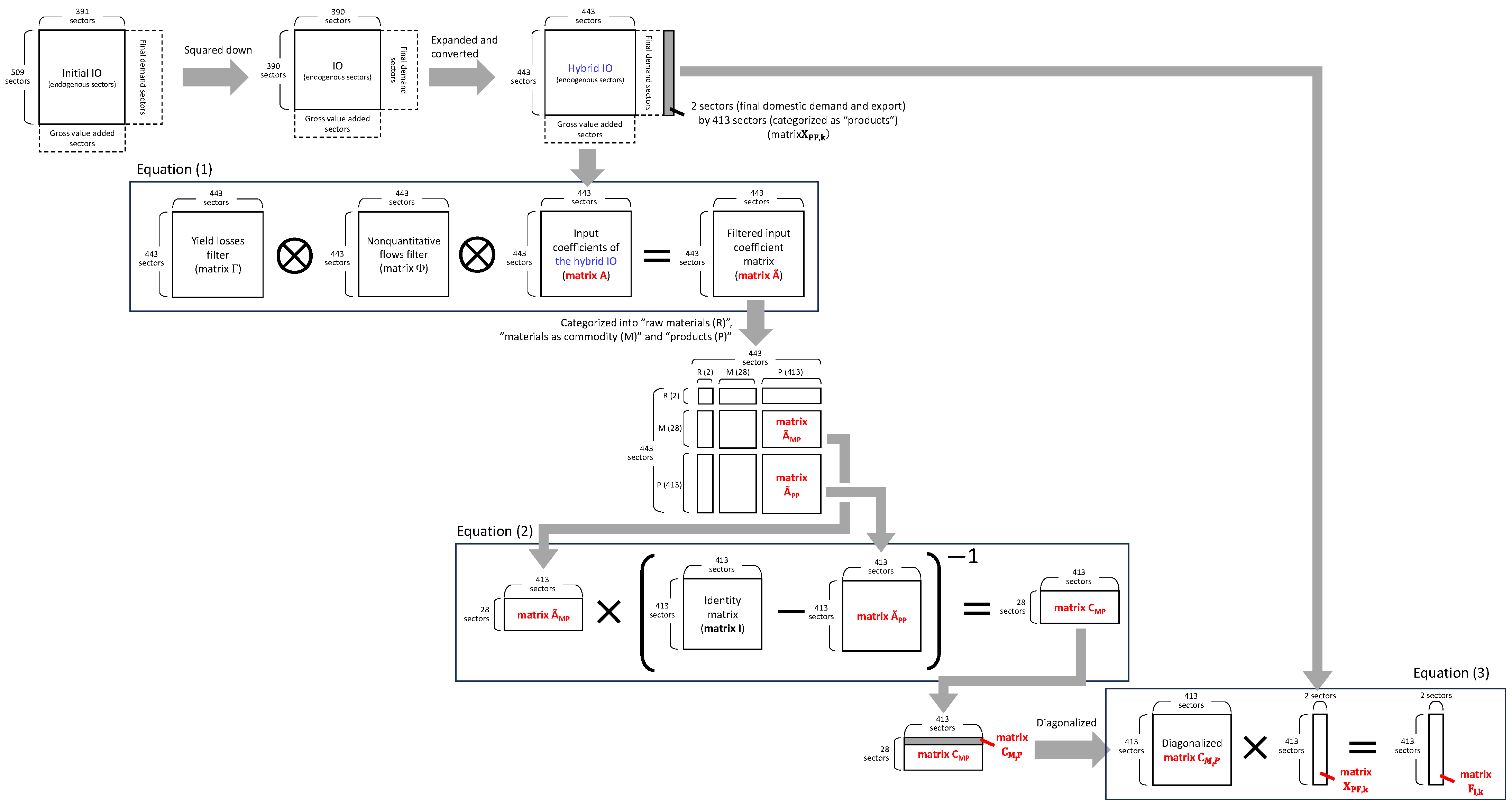
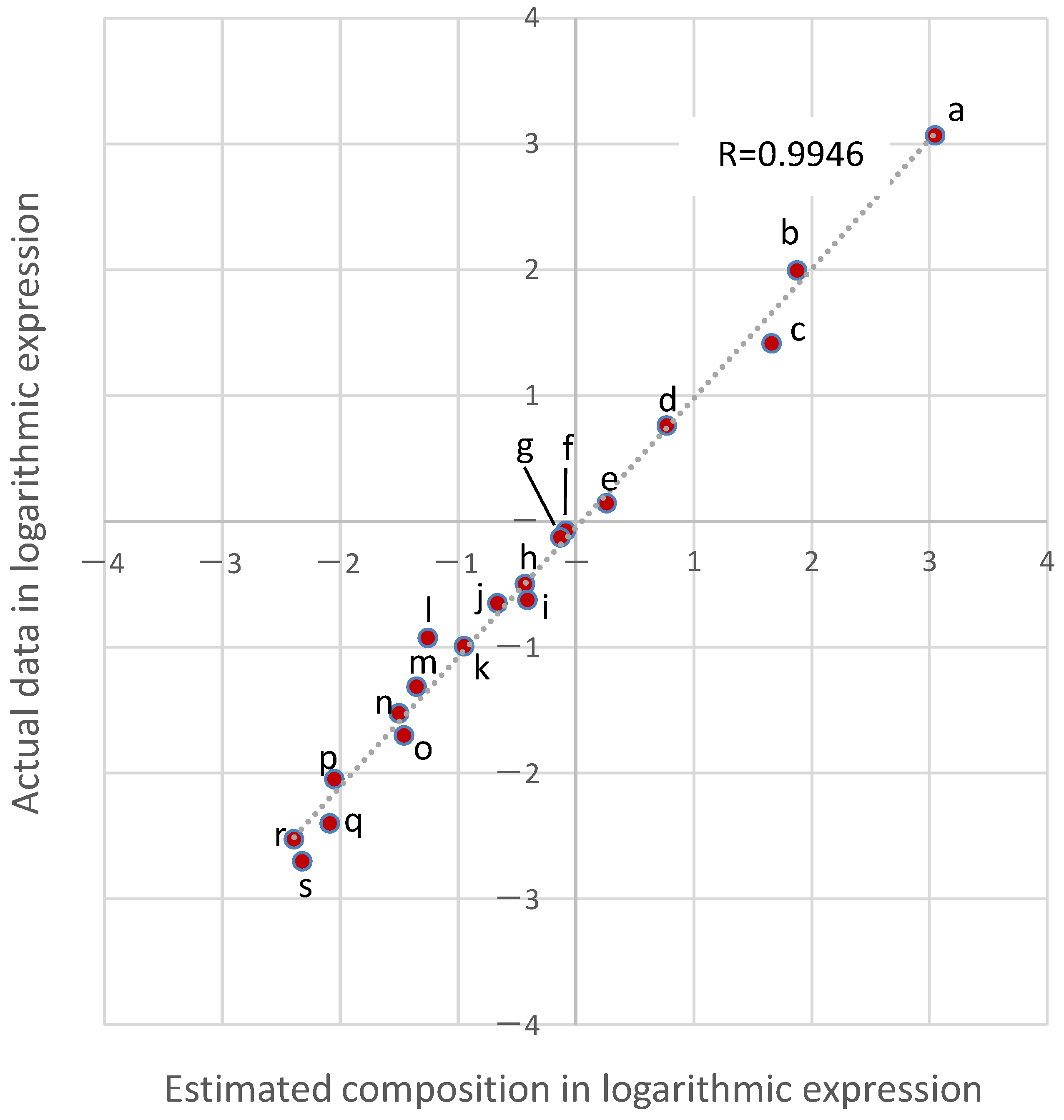


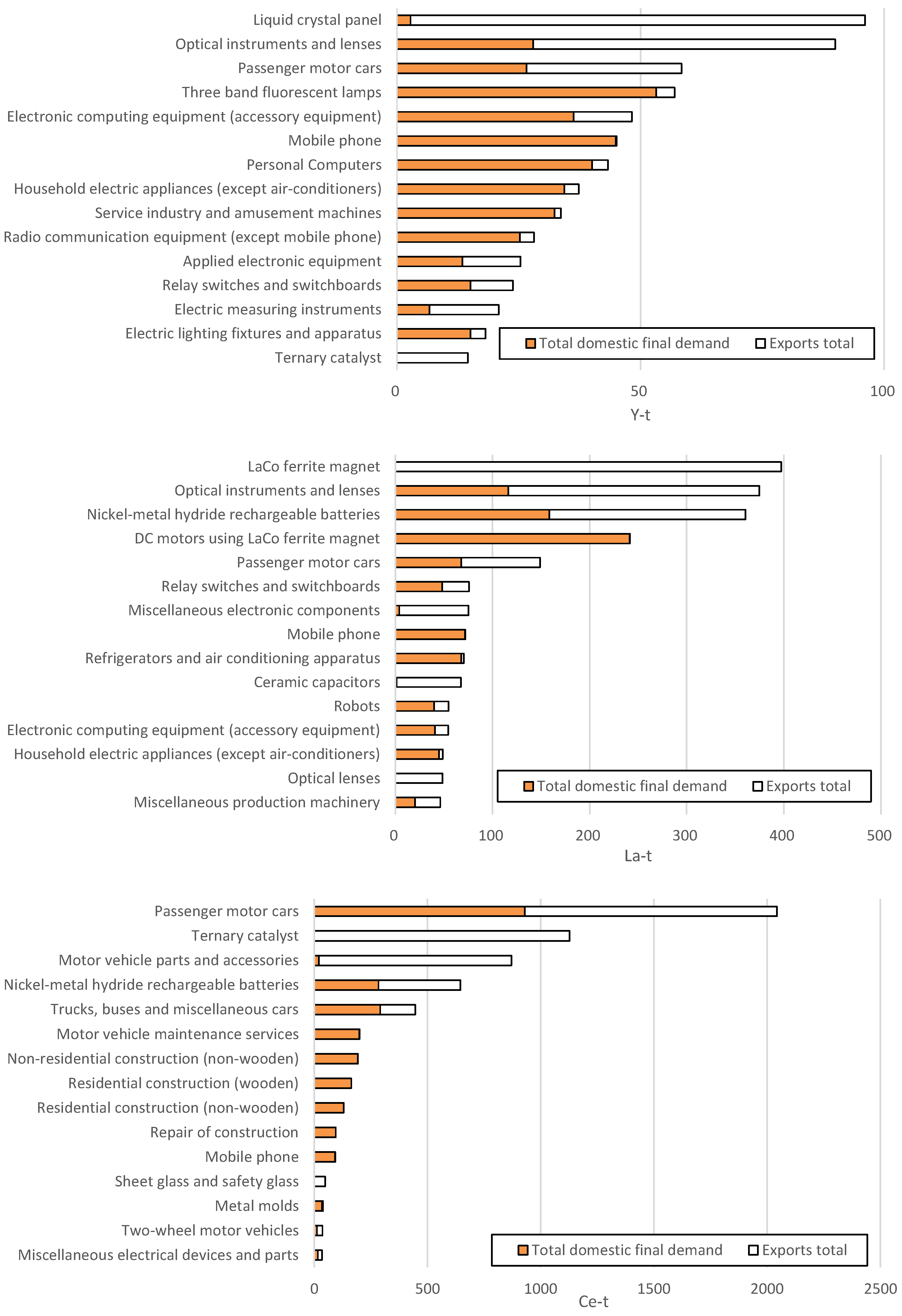

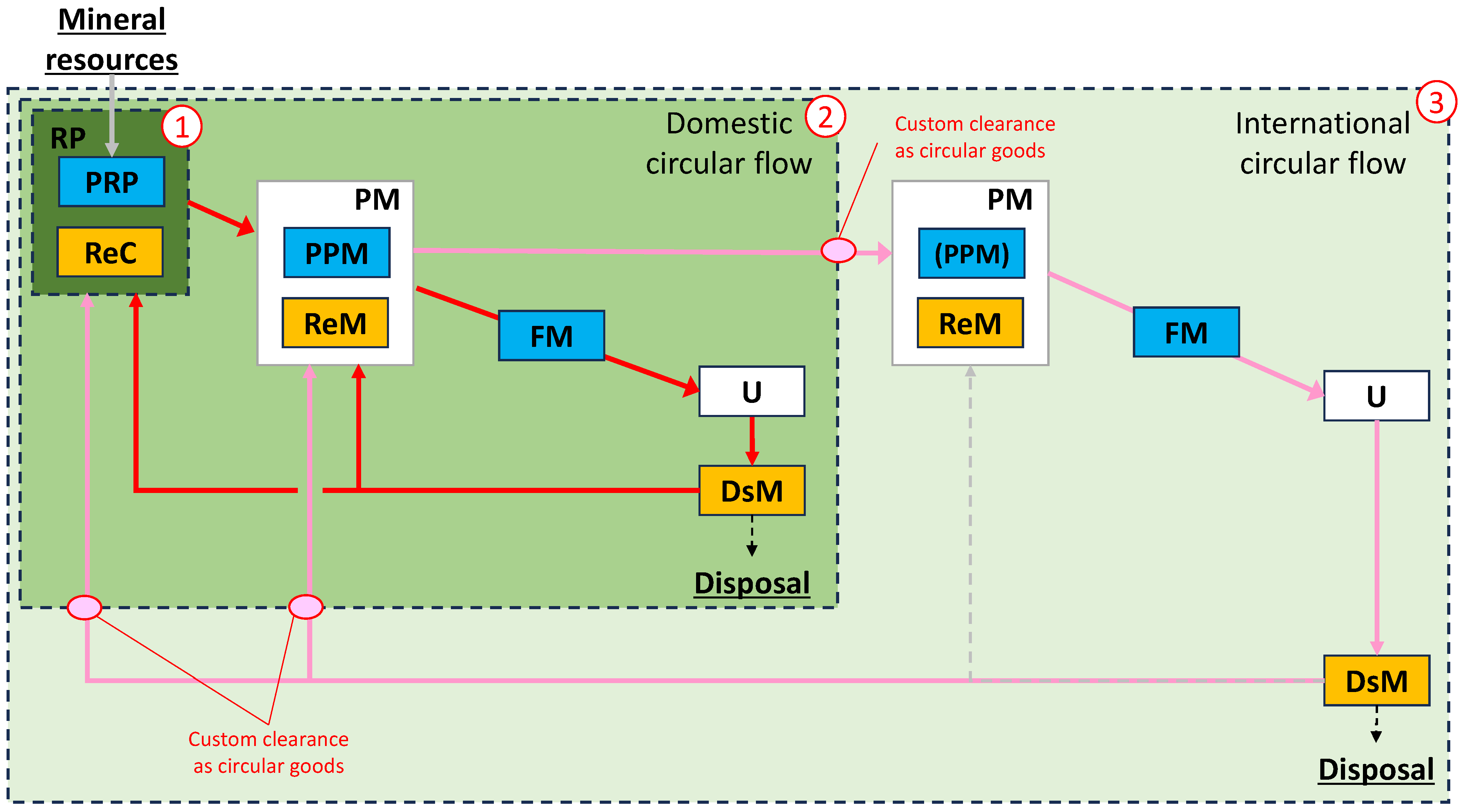
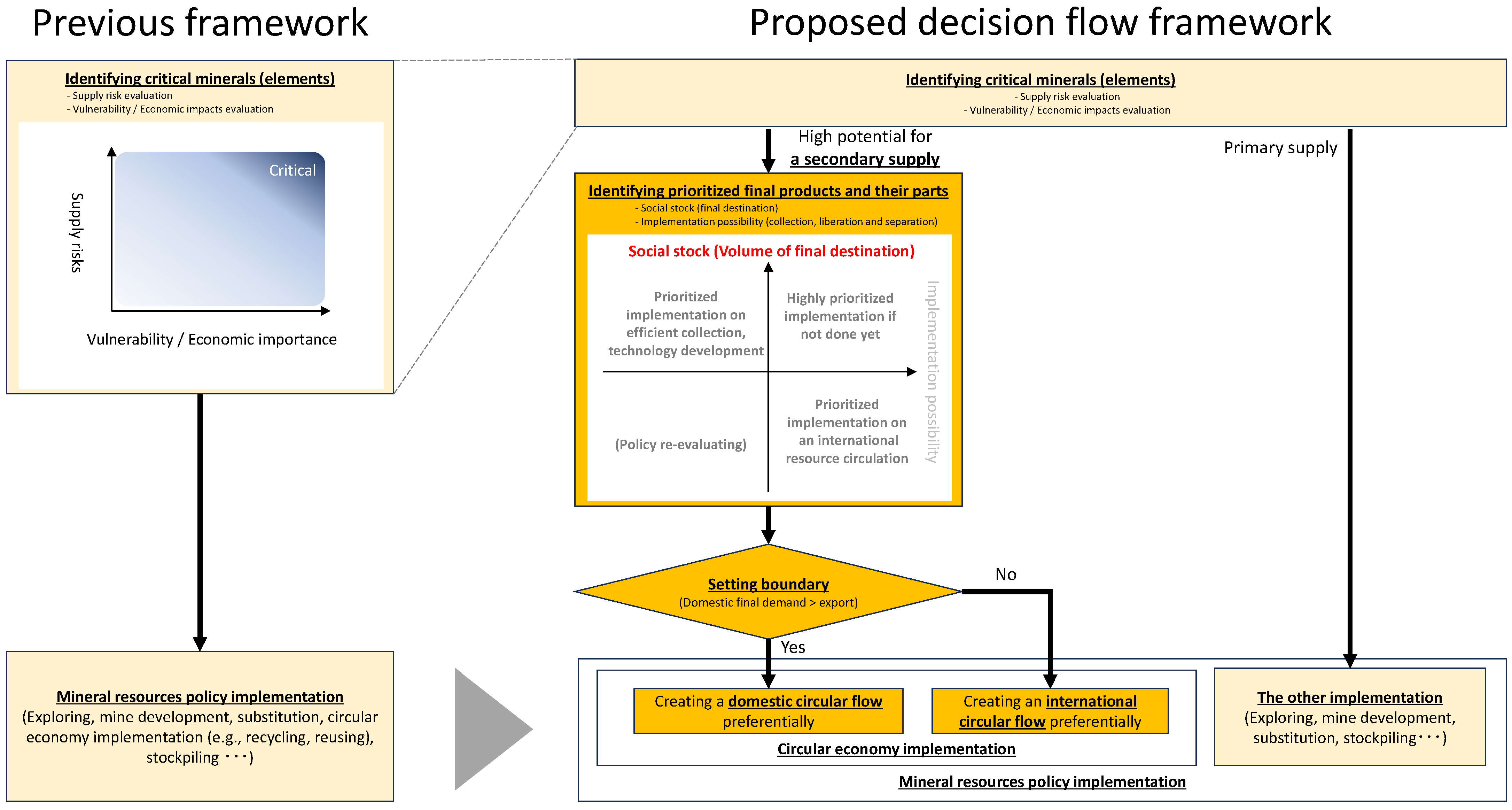
| Original Sectors | Subdivided Sectors in This Study | Evaluated Elements | ||
|---|---|---|---|---|
| Miscellaneous ores (domestic production only) | 160,237 mJPY |
| 130,954,875 t [54] | Fe |
| 4,815,914 t [65] | Cu | ||
| 4,394,770 t [65] | Co | ||
| 367,961 mJPY | - | ||
| Miscellaneous industrial inorganic chemicals | 925,461 mJPY |
| 20,921 t [65] | Li |
| 2000 t [66] | Li | ||
| 615 t [66] | Li | ||
| 402 t [59] | Co | ||
| 951 t [65] | Y (REE) | ||
| 12,365 t [65] | Ce (REE) | ||
| 898,500 mJPY | - | ||
| Miscellaneous final chemical products | 2,002,522 mJPY |
| 16,496 t [63] | Co |
| 9908 t [63] | Y, La, Ce, Nd (REE) | ||
| 958 t [65] | Ce | ||
| 1,802,279 mJPY | - | ||
| Sheet glass and safety glass | 501,284 mJPY |
| 12,989 t [66] | Ce (REE) |
| 488,295 mJPY | - | ||
| Miscellaneous glass products | 542,317 mJPY |
| 2276 t [66] | Li |
| 7648 t [54] | Y, La, Ce | ||
| 2276 t [66] | Li | ||
| 469,457 mJPY | - | ||
| Abrasive and its products | 227,375 mJPY |
| 2800 t [66] | Ce |
| 226,255 mJPY | - | ||
| Pig iron | 3,033,611 mJPY |
| 81,010,826 t [54] | Fe |
| Ferro-alloys | 338,026 mJPY |
| 1,054,265 t [54] | Fe |
| Crude steel (converters) | 4,449,985 mJPY |
| 81,081,155 t [54] | Fe |
| Crude steel (electric furnaces) | 1,481,049 mJPY |
| 24,053,223 t [54] | Fe |
| Scrap iron | 394,010 mJPY |
| 39,956,970 t [54] | Fe |
| Copper | 1,027,515 mJPY |
| 4924 t [65] | Cu |
| 1,482,601 t [54] | Cu | ||
| Aluminum (including regenerated aluminum) | 664,369 mJPY |
| 24,796 t [65] | Al |
| 1,459,036 t [65] | Al | ||
| 1,291,211 t [59] | Al | ||
| Miscellaneous non-ferrous metals | 1,500,558 mJPY |
| 207,075 t [59] | Cu |
| 68 t [57] | Li | ||
| 4679 t [59] | Co | ||
| 93,957 t [65] | Co | ||
| 0 t [65] | Co | ||
| 4260 t [59] | Co | ||
| 2264 t [65] | La (REE) | ||
| 2409 t [66] | La, Ce (REE) | ||
| 670 t [66] | Nd (REE) | ||
| 0 t [66] | Nd (REE) | ||
| 3463 t [66] | Nd (REE) | ||
| 0 t [66] | Dy (REE) | ||
| 437 t [66] | Dy (REE) | ||
| 1,327,729 mJPY | - | ||
| Non-ferrous metal scrap | 426,784 mJPY |
| 79,734 t [62] | Al |
| 1,161,769 t [62] | Al | ||
| 1,178,920 t [61] | Cu | ||
| 1278 t [65] | Co | ||
| 0 t | Co | ||
| 0 t | Nd, Dy (REE) | ||
| 189,496 mJPY | - | ||
| Miscellaneous non-ferrous metal products | 822,523 mJPY |
| 4679 t [59] | Co |
| 791,168 mJPY | - | ||
| Plumbing accessories, powder metallurgy products and tools | 949,085 mJPY |
| 8128 t [61] | Co |
| 695,902 mJPY | - | ||
| Machinists’ precision tools | 882,958 mJPY |
| 8128 t [61] | Co |
| 629,775 mJPY | |||
| Liquid crystal panel | 2,190,471 mJPY |
| 496,523,000 units [61] | Y, La, Ce (REE) |
| Flat-panel and electron tubes | 72,693 mJPY |
| 1,228,672 units [61] | Y, La, Ce (REE) |
| Miscellaneous electronic components | 5,330,247 mJPY |
| 4118 t [61] | La, Nd, Dy (REE) |
| 4,863,518 mJPY | - | ||
| Rotating electrical equipment | 1,249,851 mJPY |
| 240,383,897 units [61] | Co, La (REE) |
| 3,210,548 units [61] | Nd, Dy (REE) | ||
| 726,857 mJPY | - | ||
| Electric bulbs | 297,768 mJPY |
| 76,523,500 units [61] | Y, La, Ce (REE) |
| 263,265 mJPY | - | ||
| Batteries | 1,053,412 mJPY |
| 710,161,000 units [61] | Li |
| 983,242,000 units [61] | Li, Co | ||
| 365,003,000 units [61] | La, Ce (REE) | ||
| 537,540 mJPY | - | ||
| Miscellaneous electrical devices and parts | 750,999 mJPY |
| 8668 t [66] | Co, La (REE) |
| 11,970 t [66] | Nd, Dy (REE) | ||
| 664,598 mJPY | - | ||
| Category | Sector’s Name | Evaluated Elements |
|---|---|---|
| Raw materials (2 sectors) |
| - |
| Dy (REE) | |
| Materials as a commodity (28 sectors) |
| Fe |
| Cu | |
| Co | |
| Li | |
| Y (REE) | |
| Ce (REE) | |
| Ce | |
| Fe | |
| Fe | |
| Cu | |
| Al | |
| Al | |
| Co | |
| Co | |
| La (REE) | |
| La (REE) | |
| Ce (REE) | |
| Nd (REE) | |
| Nd (REE) | |
| Nd (REE) | |
| Dy (REE) | |
| Al | |
| Al | |
| Cu | |
| Co | |
| Co | |
| Nd (REE) | |
| Dy (REE) | |
| Products (413 sectors) | All the other sectors | - |
| Sectors | Composition Data | ||||||||||
|---|---|---|---|---|---|---|---|---|---|---|---|
| Fe | Cu | Al | Li | Co | Y | La | Ce | Nd | Dy | ||
| Ternary catalyst (t/t) | E | 0.187 | 0.011 | 0.205 | 0.000 | 0.000 | 0.005 | 0.004 | 0.371 | 0.011 | 0.000 |
| A (a) | - | - | - | - | - | 0.002 | 0.003 | 0.320 | - | - | |
| Optical lenses (t/t) | E | 0.069 | 0.003 | 0.009 | 0.000 | 0.000 | 0.008 | 0.035 | 0.000 | 0.000 | 0.000 |
| A (a) | - | - | - | - | - | 0.004 | 0.020 | - | - | - | |
| Cemented carbide tools (t/t) | E | 0.283 | 0.006 | 0.033 | 0.000 | 0.044 | 0.000 | 0.000 | 0.000 | 0.000 | 0.000 |
| A (d) | - | - | - | - | 0.049 | - | - | - | - | - | |
| Lithium-ion rechargeable batteries (g/unit) | E | 56.1 | 6.5 | 5.1 | 1.8 | 5.9 | 0.0 | 0.0 | 0.0 | 0.0 | 0.0 |
| A (b, c) | - | - | - | 1.4 | 5.8 | - | - | - | - | - | |
| LaCo magnet (t/t) | E | 0.821 | 0.001 | 0.002 | 0.000 | 0.009 | 0.000 | 0.113 | 0.000 | 0.000 | 0.000 |
| A (d, e) | 0.850 | - | - | - | 0.009 | - | 0.103 | -- | - | - | |
| NdFeB magnet (t/t) | E | 0.735 | 0.002 | 0.003 | 0.000 | 0.000 | 0.000 | 0.000 | 0.000 | 0.217 | 0.031 |
| A (f) | 0.750 | - | - | - | - | - | - | - | 0.225 | 0.030 | |
| Sectors | Composition (kg per Unit of Passenger Motor Cars) | |||||||||
|---|---|---|---|---|---|---|---|---|---|---|
| Fe | Cu | Al | Li | Co | Y | La | Ce | Nd | Dy | |
| Estimated (this study) | 1114 | 46 | 75 | 0.01 | 0.02 | 0.01 | 0.02 | 0.24 | 0.39 | 0.06 |
| Actual data [68,70] | 1169 | 26 | 99 | 0.24 | 0.12 | |||||
| Rare Earth Element (Atomic Symbol) | Major Applications |
|---|---|
| * Lanthanum (La) | LaCo ferrite magnets, optical glass, fluid catalytic cracking (FCC) catalysts, ceramic capacitors, phosphor |
| * Cerium (Ce) | Promotor for automobile exhaust gas catalysts, chemical mechanical polishing (CMP) powder, ultraviolet protection glass, fluid catalytic cracking (FCC) catalysts |
| Praseodymium (Pr) | Coloring (green) material for glass, chromogenic (yellow) material for ceramics, ceramic capacitors |
| * Neodymium (Nd) | NdFeB magnets, ceramic capacitors |
| Promethium | (Few industrial applications) |
| Samarium (Sm) | SmCo magnet |
| Europium (Eu) | Phosphor (blue and red), optical glass |
| Gadolinium (Ga) | Optical glass, neutron-absorbing material |
| Terbium (Tb) | NdFeB magnets, phosphor (green), optical glass, magneto-optical disk target |
| * Dysprosium (Dy) | NdFeB magnets, ceramic capacitors |
| Holmium (Ho) | (Few industrial applications) |
| Erbium (Er) | |
| Thulium (Tm) | |
| Ytterbium (Yb) | |
| Lutetium (Lu) | |
| * Yttrium (Y) | Phosphor (red), optical glass, stabilizing material for zirconia |
| Scandium (Sc) | Light aluminum scandium alloys |
| Rare Earth Element (Atomic Symbol) | Major Domestic Final Demands (Applications) | ||||||||
|---|---|---|---|---|---|---|---|---|---|
| Final Products | Inter. Products | ||||||||
| Three-Band Fluorescent lamps | Mobile Phones and PCs * | Cars * | Household Electric appliances * | Optical Instruments | Construction * | Robots | Nickel–Metal Hydride Batteries | DC Motors * | |
| Yttrium (Y) | ✓ | ✓ | ✓ | ||||||
| Lanthanum (La) | ✓ | ✓ | ✓ | ✓ | ✓ | ✓ | |||
| Cerium (Ce) | ✓ | ✓ | ✓ | ||||||
| Neodymium (Nd) | ✓ | ✓ | ✓ | ✓ | ✓ | ||||
| Dysprosium (Dy) | ✓ | ✓ | ✓ | ✓ | ✓ | ||||
Disclaimer/Publisher’s Note: The statements, opinions and data contained in all publications are solely those of the individual author(s) and contributor(s) and not of MDPI and/or the editor(s). MDPI and/or the editor(s) disclaim responsibility for any injury to people or property resulting from any ideas, methods, instructions or products referred to in the content. |
© 2024 by the authors. Licensee MDPI, Basel, Switzerland. This article is an open access article distributed under the terms and conditions of the Creative Commons Attribution (CC BY) license (https://creativecommons.org/licenses/by/4.0/).
Share and Cite
Shimizu, K.; Owada, S. Mineral Resources Policy for a Circular Flow of Critical Minerals: An Input–Output Approach to the Case of Their Final Destination in Japan. Sustainability 2024, 16, 726. https://doi.org/10.3390/su16020726
Shimizu K, Owada S. Mineral Resources Policy for a Circular Flow of Critical Minerals: An Input–Output Approach to the Case of Their Final Destination in Japan. Sustainability. 2024; 16(2):726. https://doi.org/10.3390/su16020726
Chicago/Turabian StyleShimizu, Kotaro, and Shuji Owada. 2024. "Mineral Resources Policy for a Circular Flow of Critical Minerals: An Input–Output Approach to the Case of Their Final Destination in Japan" Sustainability 16, no. 2: 726. https://doi.org/10.3390/su16020726
APA StyleShimizu, K., & Owada, S. (2024). Mineral Resources Policy for a Circular Flow of Critical Minerals: An Input–Output Approach to the Case of Their Final Destination in Japan. Sustainability, 16(2), 726. https://doi.org/10.3390/su16020726






